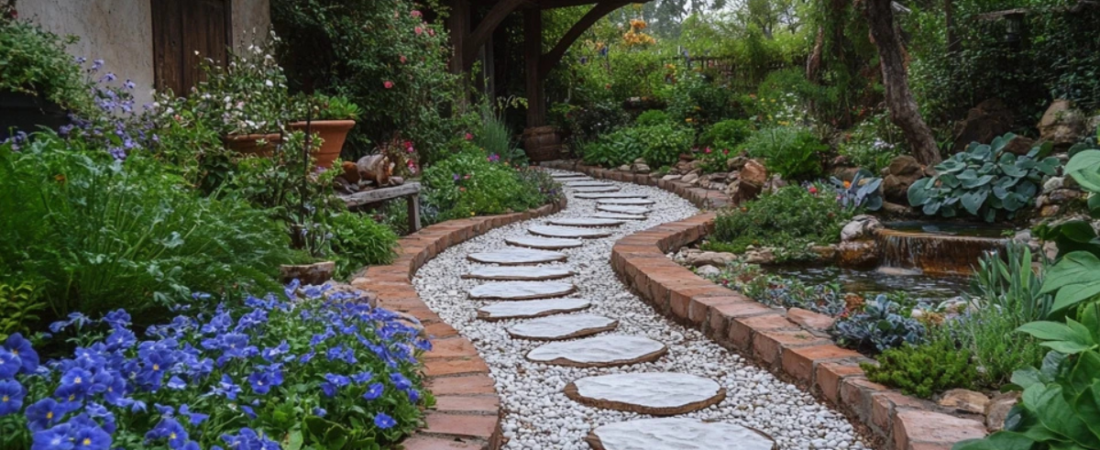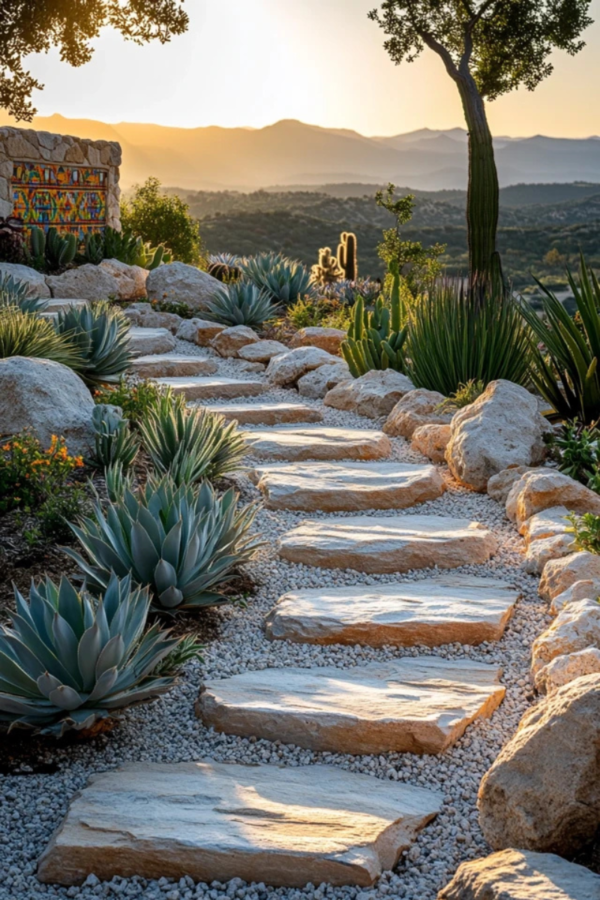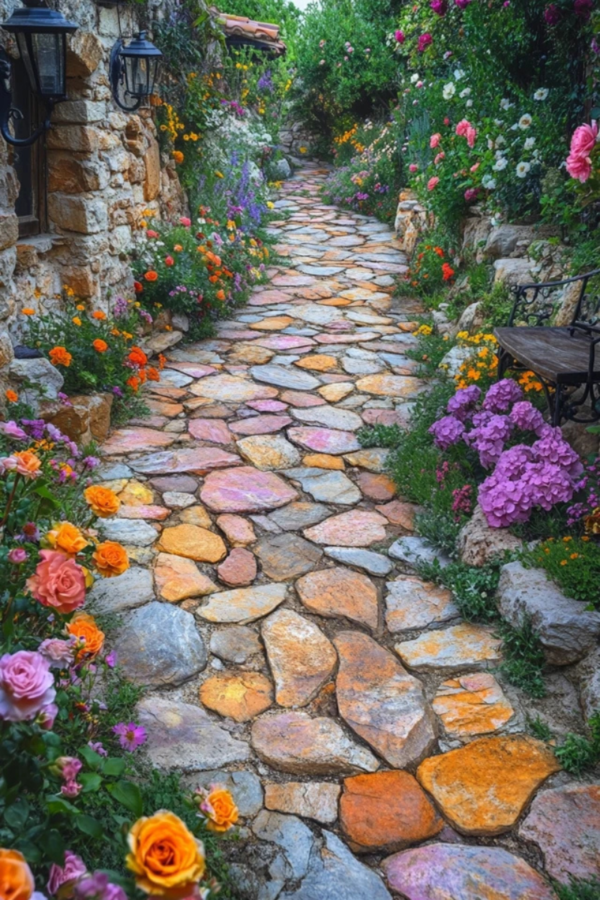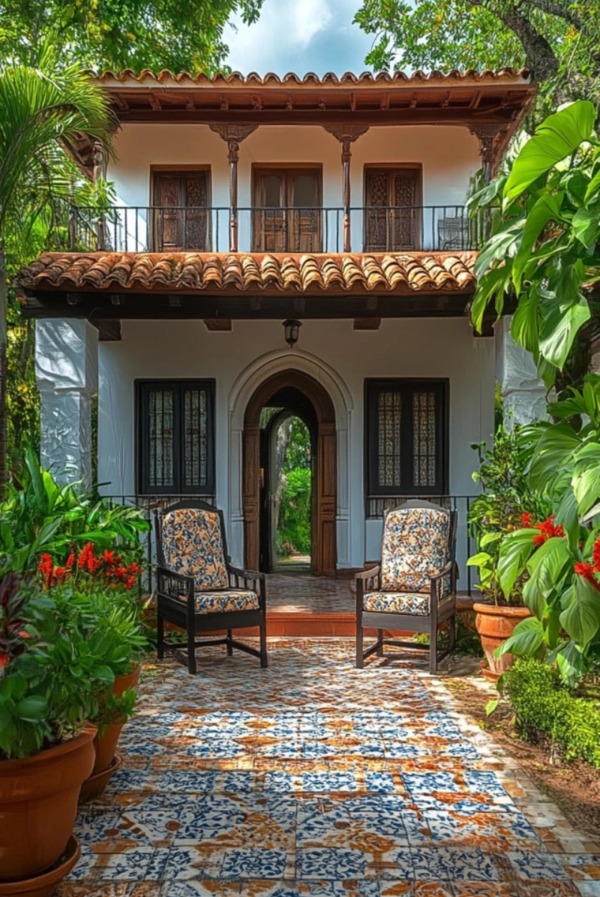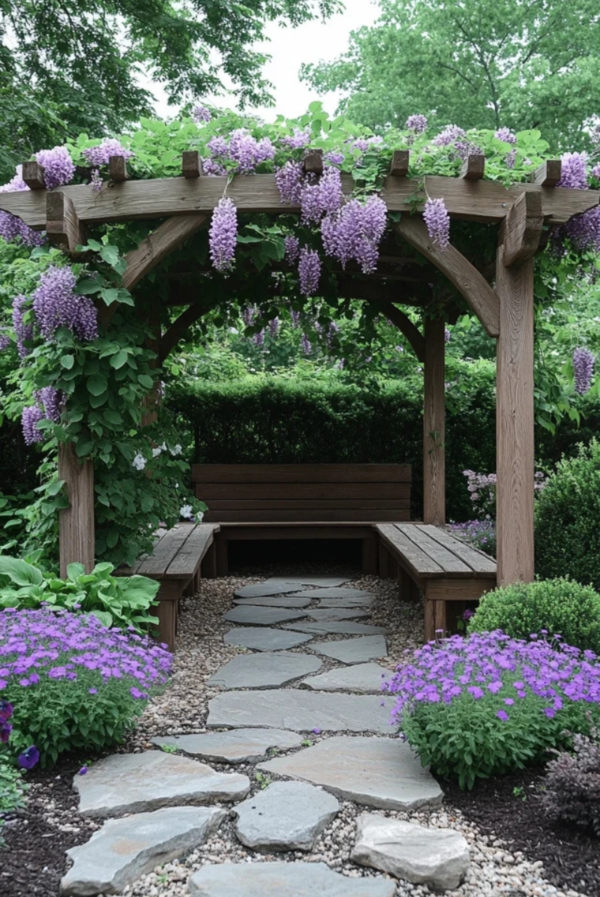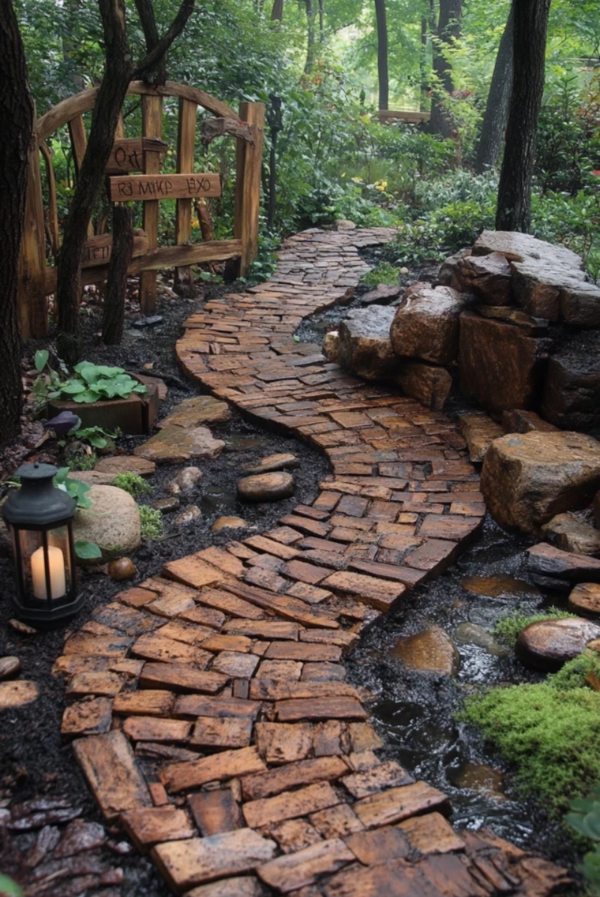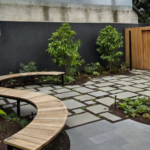We had this little strip of land between the outside of our screened-in pool area and the privacy fence—a space that felt like it was just there, existing. Too narrow to do anything major with, too open to ignore, and honestly, a little awkward. It wasn’t quite part of the yard, but it wasn’t not part of the yard either. A real conundrum of outdoor design.
After way too many Google searches and a brief, overconfident moment where I considered installing a koi pond (it was never going to happen), we landed on the best solution: a garden path. We lined the screen with plants and added white rock with odd-shaped stepping stones, and suddenly, this weird little strip of nothing became a beautiful, purposeful walkway. It’s simple, charming, and surprisingly effective at making the space feel intentional.
The best part? It turns out garden paths aren’t just about getting from point A to point B. They add texture, character, and structure to your yard. Whether you’re dreaming of a storybook-style walkway, a sleek modern design, or a budget-friendly DIY path, there’s an option for every space—even the weird ones.
Garden Paths And Walkways That Make Your Yard Feel Like a Storybook
There’s something about a garden path that instantly makes a space feel cozy, inviting, and just a little bit magical. Maybe it’s the way a well-placed stepping stone can make even the most ordinary backyard feel like a secret garden. Or maybe it’s just that walking along a defined path makes everything feel more put together—like you actually planned your landscaping instead of just winging it.
Rustic Gardens vs. Modern Walkways
Do you want your path to feel like it belongs in an enchanted forest or like it just stepped out of a luxury design catalog?
- Rustic garden paths tend to be imperfect but charming, using materials like natural stone, brick, or even wood rounds to blend seamlessly with nature. They work best when paired with lush greenery and cottage-style flowers that spill over the edges.
- Modern walkways, on the other hand, go for a clean, polished look—think sleek pavers, geometric layouts, and a tidy border. Perfect for minimalist gardens or anyone who prefers structure over whimsy.
We fell somewhere in between—our white rocks and stepping stones feel casual and natural, but they still have a little bit of modern flair.
Gravel Garden Ideas That Won’t Make You Regret Your Life Choices
Gravel is one of the easiest, cheapest ways to build a low-maintenance garden path. But let’s be real—some types of gravel are a straight-up nightmare.
- Pea gravel is soft underfoot and looks great, but it loves to scatter (and somehow ends up in your shoes even if you weren’t walking on it).
- Crushed granite compacts better, making it a great choice for a path that stays put.
- River rock looks fancy, but unless you have solid edging, those little guys will migrate faster than you can rake them back.
We went with white rocks because they brighten up the space and contrast beautifully with the stepping stones. No regrets so far.
Flagstone Pathway vs. Brick Path: A Showdown
Both flagstone and brick make incredible garden paths, but they give off completely different vibes.
- Flagstone is rugged, natural, and elegant in an effortless way. It’s great for winding, organic pathways that feel like they’ve been there forever.
- Brick is structured, classic, and has that charming, old-world appeal. It works perfectly for formal gardens, cottage landscapes, or anywhere you want a pop of warmth and texture.
Since our space was small, we opted for odd-shaped stepping stones instead of a full flagstone path—giving us the same natural look without the hefty price tag.
Cottage Garden Edging That Frames Your Path Like a Painting
A garden path isn’t just about what you walk on—it’s also about what frames the walkway. Cottage gardens do this so well by using natural, overflowing plants to soften the edges and make everything feel lush.
- Lavender, creeping thyme, and catmint create a dreamy, fragrant border.
- Low hedges like boxwood or ornamental grasses add structure.
- Stone, brick, or wood edging helps define the path while keeping gravel in place.
We kept our edging simple, letting the white rock contrast with the green plants. It keeps things clean and polished while still feeling natural.
DIY Walkway Design: Cheap, Easy, and Surprisingly Fancy
Not every path needs to be a labor-intensive project that requires renting equipment you don’t know how to use. Some of the best walkways are simple, affordable, and easy to install—and they still look amazing.
Easy Garden Paths DIY: The Lazy Gardener’s Dream
If you don’t want to spend a weekend digging trenches and laying pavers, there are plenty of easy DIY garden paths that look like you tried really hard (even if you didn’t).
- Mulch paths—super cheap, easy to install, and soft underfoot. Just be prepared to refresh it every year.
- Stepping stone paths—lay stones directly on the ground with a little sand or soil underneath. Low effort, big payoff.
- Gravel paths—rake out the gravel, add a border, and call it a day.
We went with a stepping stone and gravel combo, and it took about a day to finish. The hardest part was deciding on the layout (which took way longer than expected).
DIY Stone Path vs. DIY Brick Pathway Walkways
If you’re deciding between a stone or brick path, here’s what you need to know:
- Stone paths—casual, organic, and great for irregular layouts. Perfect if you want that “stumbled upon a secret garden” look.
- Brick paths—structured, formal, and best if you like symmetry and clean lines. They also age beautifully.
Since our space was long and narrow, we picked odd-shaped stepping stones over a full stone or brick path. It kept the walkway light, open, and flexible.
Backyard Pathway Ideas for Small Spaces
Even if you don’t have tons of room, a small pathway can still be functional and beautiful.
- Curved paths create the illusion of more space.
- Lighter-colored materials make small spaces feel bigger and brighter.
- Mixing materials (like stone with gravel or brick with ground cover plants) adds visual interest.
DIY Cement Walkway Pathways That Look Expensive
Cement might sound boring, but with the right finish, it can look surprisingly high-end.
- Stamped concrete mimics stone or brick without the price tag.
- Poured concrete slabs with grass or gravel gaps add a modern touch.
- DIY concrete stepping stones give you full control over the size and shape.
We skipped cement for our garden path, but if I ever do another one, I’d definitely try making custom stepping stones. The possibilities are endless.
Backyard Pathway Ideas for Small Spaces
Even tiny yards deserve a grand entrance. Just because you’re working with limited space doesn’t mean you have to settle for a dull, uninspired walkway. A well-planned garden path can actually make a small backyard feel bigger, guiding the eye and creating visual interest. The key is choosing materials and layouts that enhance rather than overwhelm your space.
- Curved vs. straight paths – Curved paths soften a small space, making it feel more expansive. Straight paths provide clean, structured lines that make a narrow space feel intentional.
- Light-colored materials – White gravel, pale stone, or concrete pavers reflect light and help create an airy, open feel. Dark materials tend to visually shrink a space.
- Stepping stones with ground cover – If you want a natural look, stepping stones with creeping thyme or moss in between can add charm without cluttering.
For our own garden path, we had an awkward, narrow strip between our pool screen and the fence. The fix? A white rock base with odd-shaped stepping stones. The contrast made it visually interesting, while the stepping stones kept it functional without feeling crowded.
DIY Cement Walkway Pathways That Look Expensive
Cement gets a bad rap for being boring, but with a little creativity, it can actually look high-end—without the high-end price tag.
- Stamped concrete – Mimics the look of stone, brick, or even wood with way less maintenance.
- Poured concrete slabs with gravel or grass joints – Gives a modern, designer look that’s surprisingly easy to DIY.
- DIY concrete stepping stones – Make your own custom shapes with a simple mold and a bag of cement.
If you’re working with a long, narrow space (like we were), consider large rectangular pavers with pea gravel in between. This style is modern, sleek, and can make a small yard feel larger by elongating the space. Bonus? It drains well and requires minimal upkeep.
Landscaping Walkways That Work With Your Space, Not Against It
Your walkway should enhance your yard’s natural flow, not fight against it. If you’ve ever seen a path that feels awkward or forced, it’s usually because it wasn’t designed with the existing landscape in mind.
Slope Landscaping: The Battle Against Gravity
A path on a slope can either be a charming garden staircase or an accidental Slip ‘N Slide—there is no in-between. To keep it functional (and safe), consider:
- Terraced steps – A series of short steps using stone or timber can help break up a steep slope.
- Gravel with stabilizing grids – If you prefer a continuous path, stabilizing grids keep gravel from washing away.
- Natural stone pathways – Larger, flat flagstones or boulders make a sturdy, organic-looking path.
If we had a sloped space instead of our flat, narrow walkway, I would have 100% gone for flagstone steps—because nothing says storybook garden like a winding stone staircase.
Walkway Beside House vs. Pathway Around House
Do you need a narrow walkway along the side of your house, or do you want a grand pathway wrapping around your home?
- Walkway beside the house – Keeps things functional and low-maintenance. Perfect for side yards, utility paths, or accessing backyard areas.
- Pathway around the house – Feels more like an estate feature, adding a touch of luxury and making your yard feel expansive.
Since our garden path is right up against our pool screen, we went with a compact, practical design. If we had more space, I would’ve loved to create a full wrap-around path with arching vines.
Garden Borders That Keep Your Pathway in Check
Nothing ruins a beautiful path faster than gravel spilling into the lawn or plants creeping onto the walkway like they own the place. The right garden border can fix that.
- Stone edging – Natural and blends well, but needs occasional maintenance to prevent shifting.
- Brick borders – Adds a structured, finished look while keeping things contained.
- Low hedges or flowering plants – Lavender, boxwood, or creeping thyme create soft, fragrant edges.
Our white rock garden path has clean edges that contrast against the plants, keeping everything organized but natural. It’s low-maintenance and (so far) keeps everything where it belongs.
Walkways Paths That Lead Somewhere (Or Just Look Pretty)
Not every path needs to be functional. Sometimes, it’s all about adding beauty and a sense of exploration.
- Paths leading to a garden feature – A fountain, a bench, or even a birdbath can make a short path feel intentional and inviting.
- Looping walkways – Instead of a straight path, a curved or looping layout makes the space feel bigger and more dynamic.
- “Secret” garden paths – Use tall plants or hedges to create a hidden side path that adds intrigue.
I love how our garden path naturally guides the eye, even though it technically just follows the fence line. Adding a small decorative element at the end—like a tall potted plant or a lantern—would make it feel even more like a destination.
Beautiful Home Gardens Need Beautiful Pathways
The best garden paths aren’t just functional—they add character, charm, and a sense of style to the entire yard.
Garden Path Ideas That’ll Make Your Neighbors Jealous
The right garden path has a way of turning heads—even if it’s just the neighbors doing their casual, not-so-subtle peek over the fence.
- Intricate paver designs – Herringbone, basketweave, or geometric layouts instantly make a path stand out.
- Lush, overflowing borders – Wildflowers, ferns, or cottage-style plants give it a storybook feel.
- Lighting – A few solar lanterns or pathway lights can turn a simple walkway into a magical scene at night.
Country Garden Pathway Ideas vs. English Cottage Garden Style
- Country garden paths – Think gravel, flagstone, and sprawling native plants for a relaxed, natural vibe.
- English cottage garden paths – Brick, stepping stones, or pea gravel lined with overflowing flowers for a romantic, wild-but-intentional look.
We unintentionally leaned English cottage with our stepping stones and white rock, but I’m not mad about it.
Wildflower Garden Paths That Feel Like a Scene From a Movie
Nothing feels more whimsical than a garden path framed by wildflowers. The trick is keeping it effortless yet maintained.
- Wildflower seed mix – Scatter a mix of native flowers to create a natural meadow effect.
- Irregular stepping stones – Looks charming and organic when paired with flowers growing in between.
- Minimal edging – Let the flowers spill over just a little for a soft, overgrown look.
Dream Backyard Garden Paths That Look Like You Have Your Life Together
Even if your yard is a chaotic mess of half-finished projects, a well-placed path makes it look like you’ve got everything figured out.
- Defined walkways make everything feel structured and polished.
- Matching materials across paths and patios create a cohesive look.
- Even a small, simple path adds instant charm.
Our little white rock garden path? Simple. Easy. And now, our weird side yard actually makes sense.
Creative Touches to Take Your Walkway to the Next Level
A garden path can be more than just a way to get from one place to another. It can be a focal point, a design statement, or even a tiny escape in your own backyard. The right details—whether it’s the stepping stones, lighting, or an overhead pergola—elevate a simple path into something special.
I thought our white rock and stepping stone walkway was complete, but after seeing all the ways a path can be enhanced, I realize there’s always room to level up. Here are some ideas to make a walkway feel more intentional, stylish, and even a little magical.
Garden Stepping Stones Ideas That Won’t Make You Trip
A stepping stone path is an easy way to create a charming walkway, but if the stones aren’t placed correctly, it’s basically an ankle-breaking obstacle course waiting to happen. Here’s how to do it right:
- Spacing matters – Stepping stones should be about 18 inches apart, so they match a natural walking stride. Too close? You’ll shuffle like a penguin. Too far? You’ll be hopping like a frog.
- Stability is key – Each stone should be firmly set into the ground, whether it’s in grass, gravel, or soil. No wobbly stones allowed.
- Mixing materials – Flagstone, concrete, slate, or even reclaimed bricks can be used to add personality to a stepping stone path.
In our garden, we chose odd-shaped stones to make the walkway feel organic and natural, but we made sure they were level and comfortable to walk on. No unnecessary balancing acts here.
Tiled Front Garden Paths vs. Brick Walking Path
If you want to make your garden path a statement piece, tiles and bricks are both excellent options. Each has its own unique look and vibe:
- Tiled paths – Bold, artistic, and eye-catching. You can go with Moroccan patterns, geometric designs, or even colorful mosaics to create an unforgettable entrance.
- Brick paths – Classic, structured, and timeless. Herringbone, basketweave, or running bond patterns add elegance without being overwhelming.
If I had to redo a front walkway, I’d probably lean toward a subtle brick herringbone pattern, but if I ever got ambitious, a hand-painted tile border would be a dream.
Recycled Garden Path Ideas That Are Kind to Your Wallet (And the Planet)
A beautiful garden path doesn’t have to be expensive. Some of the most creative walkways use repurposed or salvaged materials, giving old items new life.
- Broken concrete pavers – Sometimes called “urbanite,” salvaged concrete can be arranged like flagstone for a zero-cost stepping stone path.
- Reclaimed brick – Old bricks from construction sites or salvage yards can be turned into charming, rustic pathways.
- Wood slices – Large tree stumps or cut logs make an earthy, natural walkway (though sealing them is a must to prevent rot).
- Crushed shells or recycled glass – Crushed oyster shells are a classic choice for coastal garden paths, and crushed glass adds a subtle sparkle when the sun hits it just right.
If I had thought ahead, I would have checked out local salvage yards for old bricks or reclaimed wood before settling on white rock. But I’ll keep this in mind for future projects—maybe an upcycled garden border?
Garden Pathway Lighting That Turns Your Yard Into a Glow-Up Moment
There’s something magical about a softly lit garden path at night. The right lighting makes a walkway feel cozy, inviting, and a little bit enchanted.
- Solar path lights – Easy to install, eco-friendly, and available in tons of styles.
- Recessed lighting – Small lights embedded into the path or walkway border for a sleek, modern look.
- Lantern-style lights – Classic, warm, and perfect for a storybook cottage feel.
- String lights – Draped along a fence or wrapped around nearby trees, they create a soft, dreamy glow.
- Glow-in-the-dark pebbles – Okay, this one is just for fun. But imagine your path glowing at night without any wiring or batteries?
Our garden path is currently unlit, but now that I think about it, some soft lighting along the stepping stones would make it feel even more intentional.
Pergola Ideas Over Your Garden Path
Want to instantly upgrade a garden path? Put a pergola over it. It adds structure, charm, and a sense of arrival—even if your path just leads to a backyard seating area.
- Classic wooden pergolas – Ideal for a rustic, elegant look.
- Metal pergolas – Sleek, durable, and perfect for modern gardens.
- Arched trellises – A more delicate alternative, great for growing climbing vines.
- Mini pergolas – Even a small, decorative archway at the start of a path adds drama and character.
If I had more space, I would’ve considered adding a mini pergola at the entrance to our pathway, just to create that grand entrance feel.
Bringing It Back to Our Own Garden Path
Looking back, I’m so glad we turned that awkward space between our screened-in pool area and privacy fence into a garden path. It was a simple solution, but it completely changed the feel of the space.
Now, I’m realizing that there are so many ways to take it even further—maybe adding some lighting, a little decorative border, or even a few plants that spill over onto the path.
If there’s one thing I’ve learned, it’s that a walkway isn’t just about function—it’s about personality. Whether you keep it simple with stepping stones or go all-in with a tiled masterpiece and a pergola, the best garden paths are the ones that feel like they belong in your space.
FAQs: Everything You Need to Know About Garden Paths
What is the cheapest material for a garden path?
The most budget-friendly options for Garden Paths and Walkways include gravel, mulch, and recycled materials. Pea gravel is a popular choice because it’s inexpensive, easy to install, and provides a natural look. Mulch paths are another cost-effective option, offering a soft, organic feel while helping with moisture retention. If you’re looking for something even cheaper, recycled brick, salvaged wood, or broken concrete pavers can create a rustic and unique Backyard Pathway for little to no cost.
What is the cheapest garden path?
A Gravel Garden path is often the cheapest solution. It requires minimal preparation—just clear the area, lay a weed barrier, and spread the gravel. Mulch walkways are another ultra-affordable choice, especially if you use materials like wood chips or pine needles from your own yard. For an even more DIY approach, try a Recycled Garden Path, using leftover bricks, stones, or even repurposed stepping stones to create a free or low-cost Garden Pathway.
How do you make a simple garden path?
The easiest DIY Garden Path can be done with just a few materials and a little effort. Start by outlining your path with a garden hose or string, then remove any grass or weeds. Add a weed barrier fabric to prevent regrowth, and then lay your chosen material—this could be pea gravel, stepping stones, pavers, or even mulch. To keep things looking neat, consider adding Cottage Garden Edging like bricks, wood, or metal edging to frame your path.
What is the best walkway for a garden?
The best Garden Pathway depends on your style, budget, and maintenance preferences. Flagstone pathways are a beautiful and durable option, creating a natural, high-end look. Brick Walkway Ideas are timeless and structured, adding charm to Cottage Garden Walkways. If you prefer something low-maintenance, Paver Walkway Ideas offer a clean, modern look while being easy to install. For a soft, romantic feel, a Wildflower Garden Path with stepping stones nestled in greenery is a perfect choice.

